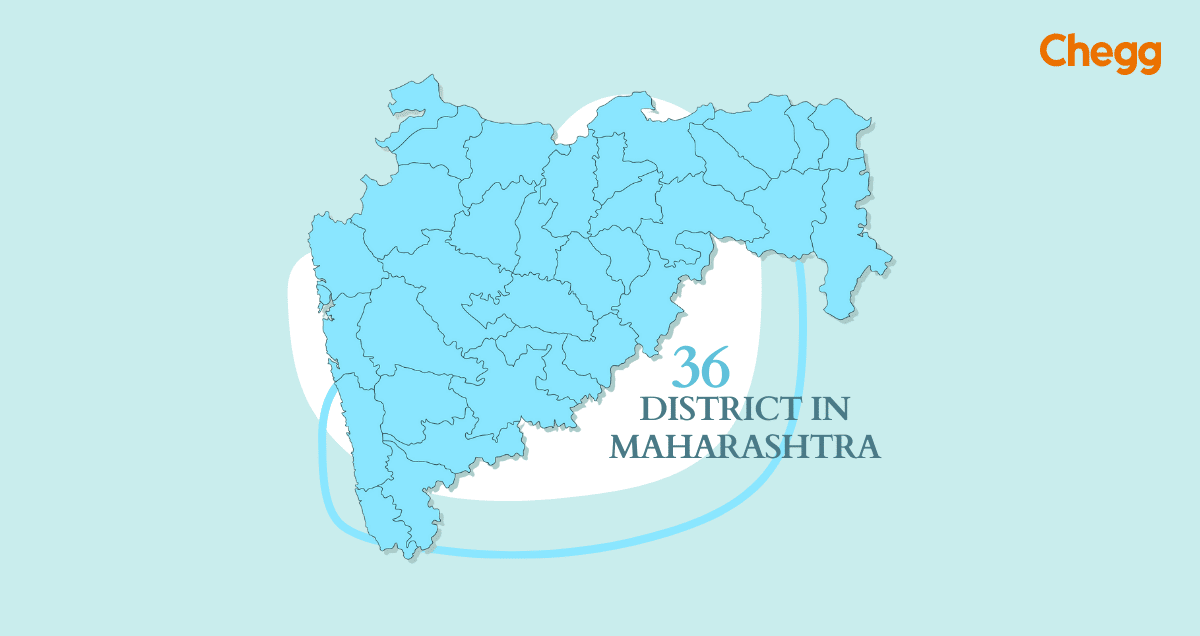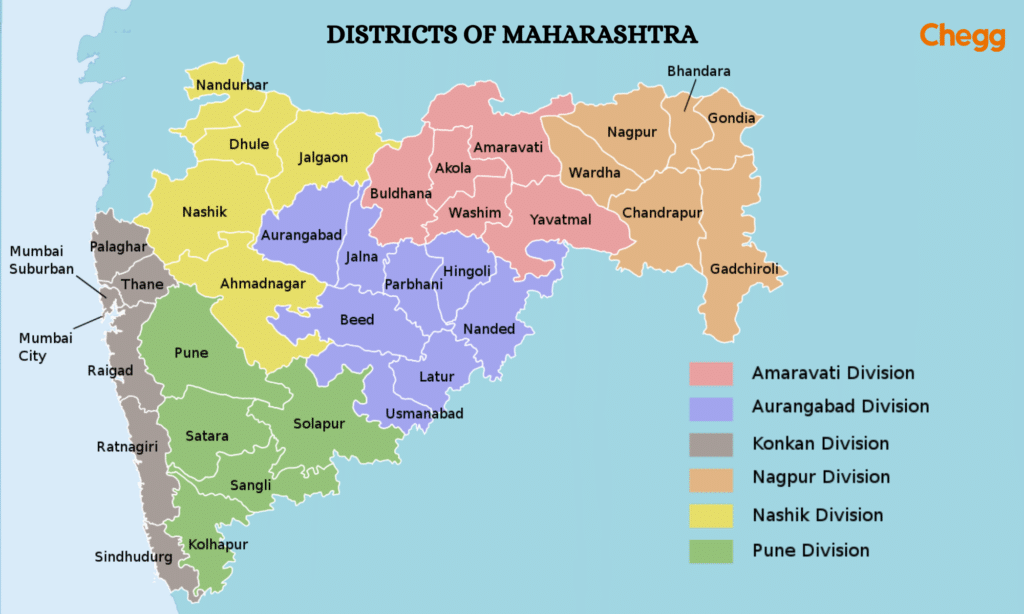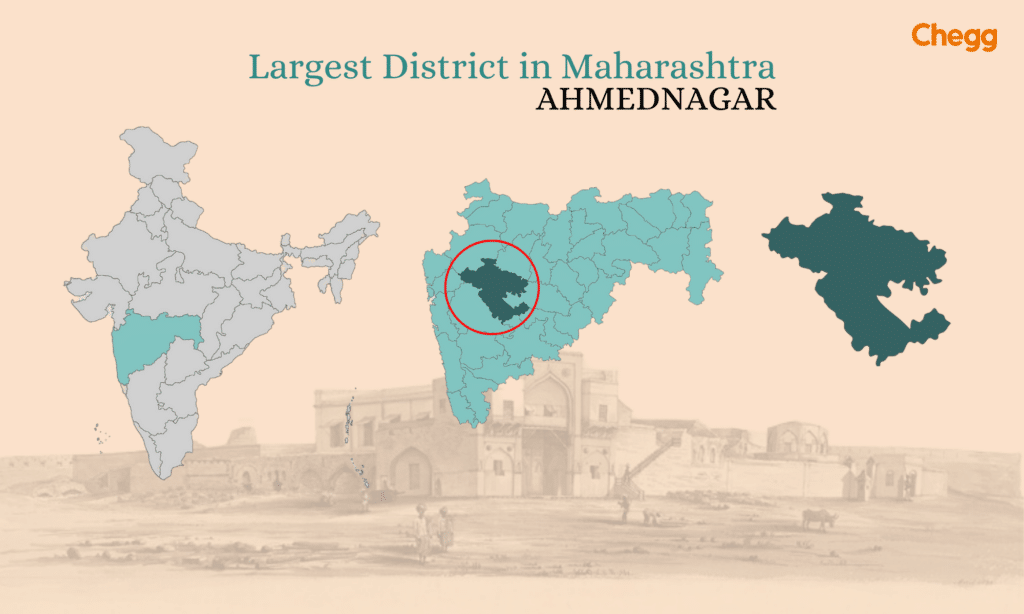
Quick Summary
Table of Contents
Maharashtra is India’s third biggest state with a total area of 307,713 km2. But how many district in Maharashtra are there? There are a total of 36 districts in Maharashtra, each with a different population, size, economy, and level of development.
Now, think of these districts as puzzle pieces that make up the state. Each district has a leader called a district collector who looks after things in that area. They then divide these districts into smaller parts like talukas, villages, and towns. This setup helps the government run things smoothly, make sure everyone is safe, and deliver services to people who live in these areas
On May 1, 1960, the state of Maharashtra, meaning “The Great State,” was established. But its history goes way back. Many ancient empires like the Mauryas, Satavahanas, Chalukyas, and the powerful Marathas have ruled this land. Chatrapati Shivaji, a legendary figure, led the Maratha Empire and left a lasting legacy. This rich history is a big part of what makes Maharashtra what it is today.
Maharashtra is a fascinating state with a mix of beautiful nature and bustling city life. From the famous skyline of Mumbai to the peaceful hills, it offers a wide range of experiences. Do you have any specific questions about Maharashtra? Its diversity helps create vibrant agriculture and unique landscapes.
The Western Ghats in Maharashtra are a beautiful mountain range with lots of plants and animals. It’s a great place for people who love nature and want to go trekking. It’s a peaceful escape from city life.
In Maharashtra, you’ll find lively cities like Mumbai and Pune. People know Mumbai as the “City of Dreams” and recognize it as a major hub for finance and entertainment. It’s a diverse and bustling place with a big film industry. Pune is famous for its schools and is a center for new ideas and technology.
Vidarbha, in the eastern part of Maharashtra, looks very different with its dry landscapes. The area has some challenges because of its semi-dry climate, but it’s still an important place for farming. Farmers in Vidarbha are good at growing crops in these conditions, which helps the state’s agriculture.
Maharashtra has different types of land for farming. They grow rice and sugarcane in the flat areas and grapes and oranges in the hilly areas. Maharashtra is really important for India’s food. It has cities and nature, like the Western Ghats, and dry places. Maharashtra shows how India can be different and still do well.
Mumbai, situated in Maharashtra, holds the title being India’s financial capital. Maharashtra contributes 14% to India’s total economic output, known as Gross Domestic Product (GDP). Its strong economy comes from its location, industries, business centers like Mumbai, and services sector.”
The state of Maharashtra has 350 forts. Each of these forts has its own story and history. Some famous ones are Raigad, Sinhagad, and Pratapgad. These forts are like time machines that take us back to different times and battles. They’re not just old walls; they’re like windows to the past.
In a nutshell, Maharashtra is a land of history, diverse landscapes, economic strength, and an abundance of forts. It continues to play a crucial role in India’s growth and has a rich cultural tapestry that’s worth exploring.
The Maharashtra state is divided into 6 revenue divisions, each consisting of multiple districts:
1. Amravati
2. Aurangabad
3. Konkan
4. Nagpur
5. Nashik
6. Pune
Marathwada is a proposed state and geographical area of Maharashtra, India. During the Nizam regime, it became a part of the then Hyderabad state. The region is the same as the Aurangabad district of Maharashtra. Its historical and cultural importance defines its location in the southeastern part of the state.
Here are the districts of the Marathwada region:
| Districts | Area (km2) |
| Aurangabad | 10,100 |
| Beed | 10,693 |
| Jalna | 7,687 |
| Dharashiv | 7,569 |
| Nanded | 10,528 |
| Latur | 7,157 |
| Parbhani | 6,251 |
| Hingoli | 4,526 |
If you are curious about how many districts in Maharashtra are there. Here is a table showing the list of 36 districts in Maharashtra state, along with their sizes and populations.
| No | District | Area (in sq. km) | Population |
| 1 | Ahmednagar | 17,048 | 4,543,159 |
| 2 | Akola | 5,431 | 1,818,617 |
| 3 | Amravati | 12,235 | 2,888,445 |
| 4 | Aurangabad | 10,100 | 3,695,928 |
| 5 | Beed | 10,693 | 2,585,303 |
| 6 | Bhandara | 3,819 | 1,200,334 |
| 7 | Buldhana | 9,661 | 2,586,258 |
| 8 | Chandrapur | 11,443 | 2,204,307 |
| 9 | Dhule | 8,063 | 2,050,862 |
| 10 | Gadchiroli | 14,412 | 1,072,942 |
| 11 | Gondia | 5,431 | 1,322,331 |
| 12 | Hingoli | 4,526 | 1,177,345 |
| 13 | Jalgaon | 11,765 | 4,224,442 |
| 14 | Jalna | 7,718 | 1,959,046 |
| 15 | Kolhapur | 7,685 | 3,876,001 |
| 16 | Latur | 7,157 | 2,454,196 |
| 17 | Mumbai City | 157 | 3,085,411 |
| 18 | Mumbai Suburban | 369 | 9,356,962 |
| 19 | Nagpur | 9,892 | 4,653,171 |
| 20 | Nanded | 10,529 | 3,361,292 |
| 21 | Nandurbar | 5,099 | 1,648,295 |
| 22 | Nashik | 15,530 | 6,107,187 |
| 23 | Osmanabad | 7,569 | 1,660,311 |
| 24 | Palghar | 8,395 | 2,990,116 |
| 25 | Parbhani | 6,224 | 1,835,982 |
| 26 | Pune | 15,642 | 9,426,959 |
| 27 | Raigad | 7,152 | 2,634,200 |
| 28 | Ratnagiri | 8,208 | 1,612,672 |
| 29 | Sangli | 8,572 | 2,822,143 |
| 30 | Satara | 10,480 | 3,003,741 |
| 31 | Sindhudurg | 5,207 | 849,651 |
| 32 | Solapur | 14,895 | 4,317,756 |
| 33 | Thane | 9,558 | 11,060,148 |
| 34 | Wardha | 6,309 | 1,300,774 |
| 35 | Washim | 5,150 | 1,196,714 |
| 36 | Yavatmal | 13,582 | 2,772,348 |

The government of Maharashtra added a few more districts over time to the 26 district in Maharashtra that existed in the newly created Indian state of Maharashtra in 1960. Here’s the Maharashtra district timeline.
There were about 26 Districts in Maharashtra before 1960 and below is the Maharashtra district list.
| Yavatmal | Wardha |
| Thane | Solapur |
| Satara | Sangli |
| Ratnagiri | Raigad |
| Pune | Parbhani |
| Osmanabad | Nashik |
| Nanded | Nagpur |
| Mumbai City | Kolhapur |
| Jalgaon | Dhule |
| Bhandara | Beed |
| Aurangabad | Amravati |
| Ahmadnagar | Akola |
| Chandrapur | Buldhana |
| Year | Districts in Maharashtra added after 1960 |
| 1981 | Districts of Jalna and Sindhudurg were added. |
| 1982 | The districts of Latur and Gadchiroli were included. |
| 1990 | The district of Mumbai Suburban was created. |
| 1998 | Washim and Nandurbar districts were added. |
| 1999 | Hingoli and Gondia districts were established. |
| 2014 | The district of Palghar was included |
Mumbai City District is the smallest district in Maharashtra, covering just 157 square kilometers. It’s home to Mumbai, India’s financial hub, and has a population of about 21.3 million people. The financial sector, Bollywood, and historical landmarks like the Gateway of India and Chhatrapati Shivaji Terminus make the district well-known.
The Mumbai City District may be small, but it has a big impact on Maharashtra and the whole country. It’s an important financial and cultural center with a large population, making it a standout district in Maharashtra.

Ahmednagar is the largest district in Maharashtra, known for its rich history and culture. It’s famous for the Shirdi Sai Baba Temple, a popular pilgrimage site. The district also has forts, monuments, and historical sites from the Maratha Empire. People also know Ahmednagar for its agriculture. It’s a great place to explore Maharashtra’s diverse heritage.

Also Read:-
How Many Districts in Karnataka? | An Overview
How Many Districts in West Bengal? Brief Overview
How Many Districts in India: State Wise List of Districts
Maharashtra, a state known for its diverse landscape and growing population, is thinking about creating new districts to make governing and administration easier. Here’s the Maharashtra district list, along with some details about each:
The proposed Nashik District will emerge from parts of Malegaon and Kalwan.
Thane district, an important district in Maharashtra, will expand further by incorporating areas from Mira-Bhainder and Kalyan.
Buldana, a proposed district, will encompass regions currently part of Khamgaon. This area is notable for its agricultural activities and cotton production.
Achalpur, a proposed district in Maharashtra, would form from Amravati. Amravati itself is known for its educational institutions and cultural heritage.
Sakoli will become a new district in Maharashtra, separating from Bhandara. This region is rich in natural resources and forestry.
The proposal suggests separating Chimur from Chandrapur. Chandrapur is known for its coal mines and wildlife sanctuaries.
Aheri would be created from Gadchiroli. This region is a significant part of Maharashtra’s tribal belt.
Bhusawal, formed from Jalgaon, is an important agricultural and industrial hub in Maharashtra.
Udgir aims to become independent by separating itself from Latur. Latur is known for its historical and cultural heritage.
Ambejogai, carved out of Beed, is a region with religious and historical significance.
Kinwat as a district would be separated from Nanded, which has a rich historical background.
Mandesh aims to be a new district within Satara, a region famous for its strawberries and cultural heritage.
| District | Geographical Significance | Economic Significance | Cultural Significance |
|---|---|---|---|
| Mumbai City | Coastal area, India’s financial hub | Finance, entertainment industry | Cosmopolitan lifestyle, center for Bollywood |
| Mumbai Suburban | Urban sprawl along the coast | Residential zones, commercial centers | Cultural diversity, bustling urban environment |
| Thane | Coastal and hilly regions | IT sector, industrial development | Heritage sites, vibrant festivals |
| Palghar | Coastal belt with forest cover | Tourism, industrial expansion | Tribal heritage, scenic beauty |
| Raigad | Coastal area with forts | Agriculture, tourism, and industries | Historical monuments, coastal lifestyle |
| Ratnagiri | Scenic beaches along the coast | Mango farming, fishing, tourism | Konkan cuisine, traditional arts |
| Sindhudurg | Pristine beaches, coastal environment | Agriculture, fishing, tourism | Ancient forts, temples, local crafts |
| Pune | Hilly region with fertile plains | Education, IT, manufacturing | Renowned for classical music and institutions |
| Satara | Hilly and fertile terrain | Agriculture, tourism, industries | Historical sites, hill stations |
| Sangli | Riverbank location, fertile plains | Sugarcane farming, industries | Religious festivals, temples |
| Kolhapur | Fertile land, known for heritage sites | Agriculture (jaggery), manufacturing | Wrestling culture, Kolhapuri cuisine |
| Solapur | Arid plains, historic importance | Textiles, agriculture | Religious fairs, local festivals |
| Nashik | Hilly area, vineyards | Wine production, agriculture | Kumbh Mela, pilgrimage tourism |
| Dhule | Agricultural landscape, riverside | Cotton farming, small industries | Local crafts, traditional fairs |
| Nandurbar | Hilly region, tribal population | Handicrafts, agriculture | Tribal traditions, festive events |
| Jalgaon | Agricultural plains by rivers | Banana and cotton farming, industries | Ajanta caves, pilgrimage sites |
| Ahmednagar | Fertile plains with heritage landmarks | Grapes and sugarcane farming, industries | Historic monuments, religious events |
| Aurangabad | Hilly area, UNESCO heritage sites | Tourism, auto-manufacturing sector | Cultural festivals, heritage tourism |
| Jalna | Agricultural land, historical relevance | Pharmaceutical industries, agriculture | Historic monuments, cultural festivals |
| Beed | Arid region with historical importance | Agriculture, small industries | Ancient forts, cultural heritage |
| Osmanabad | Arid plains with notable landmarks | Small-scale industries, agriculture | Folk arts, historic sites |
| Nanded | Fertile land, pilgrimage significance | Religious tourism, agriculture | Sikh pilgrimage center, historical significance |
| Latur | Arid plains with educational relevance | Agriculture, educational institutions | Historic forts, traditional music |
| Hingoli | Arid terrain with historic landmarks | Small industries, agriculture | Local festivals, cultural heritage |
| Parbhani | Arid plains, historic background | Education, agriculture | Cultural events, monuments |
| Amravati | River plains, cotton-growing region | Agriculture, manufacturing | Cultural activities, historical sites |
| Akola | Plains along rivers | Cotton industries, agriculture | Cultural festivals, monuments |
| Yavatmal | Plains and riverside terrain | Cotton and soybean farming, industries | Folk arts, local celebrations |
| Buldhana | Agricultural land along rivers | Industry, agriculture | Religious and historical sites |
| Washim | Plains by rivers | Agriculture, small industries | Local fairs, historical landmarks |
| Nagpur | Central location, “Orange City” | Trade, education, industries | Cultural events, historic landmarks |
| Wardha | Agricultural land with historic sites | Textile industries, agriculture | Gandhian heritage, cultural events |
| Bhandara | Forested land near rivers | Agriculture, industry | Wildlife sanctuaries, tribal culture |
| Gondia | Forested area by rivers | Agriculture, small-scale industries | Traditional crafts, wildlife sanctuaries |
| Chandrapur | Forested terrain with minerals | Mining, agriculture, industry | Wildlife sanctuaries, local festivals |
| Gadchiroli | Dense forests with tribal populations | Agriculture, forest produce | Eco-tourism, tribal culture |
In summary, the article gives a detailed explanation of how many district in Maharashtra are there. The districts offer a mix of culture, history, and diversity. From the busy city of Mumbai to the peaceful villages along the Konkan coast, each district has its own unique character and importance. Maharashtra’s districts are not just administrative areas; they hold heritage, economic activity, and natural beauty. Maharashtra values both tradition and progress, as seen from its districts, ranging from the largest district of Ahmednagar, renowned for its religious significance and agriculture, to the proposed new districts aimed at enhancing the state’s administration.
There are 36 districts in Maharashtra, further divided into 6 revenue divisions. These 36 districts are further divided into 109 sub-divisions of the 357 talukas.
Ahmadnagar district is the biggest district in Maharashtra with an area of 17,048 sq. km.
Maharashtra is divided into 6 administrative divisions: Konkan, Pune, Nashik, Aurangabad, Amravati, and Nagpur. These divisions are further divided into 36 districts.
Mumbai Suburban, with a GDP per capita of more than $13,000, is regarded as the wealthiest district in Maharashtra.
The smallest district in Maharashtra in terms of area is Mumbai City, which is only 157 square kilometers.
Palghar is Maharashtra’s newest district. On August 1, 2014, the Maharashtra government created this new district.
Districts such as Washim, Gadchiroli, Yavatmal, and Buldhana in Maharashtra face economic challenges, with per capita incomes below ₹1.5 lakh in 2022-23. In contrast, urban centers like Mumbai, Pune, Thane, and Nagpur reported incomes above ₹3 lakh.
Maharashtra has 358 talukas across its 36 districts, each serving as an important administrative division within the state.
Gadchiroli district is the second largest district in Maharashtra, covering around 14,412 sq km. It is known for its rich forests, tribal communities, and natural resources.

Authored by, Amay Mathur | Senior Editor




Amay Mathur is a business news reporter at Chegg.com. He previously worked for PCMag, Business Insider, The Messenger, and ZDNET as a reporter and copyeditor. His areas of coverage encompass tech, business, strategy, finance, and even space. He is a Columbia University graduate.
Editor's Recommendations
Chegg India does not ask for money to offer any opportunity with the company. We request you to be vigilant before sharing your personal and financial information with any third party. Beware of fraudulent activities claiming affiliation with our company and promising monetary rewards or benefits. Chegg India shall not be responsible for any losses resulting from such activities.
Chegg India does not ask for money to offer any opportunity with the company. We request you to be vigilant before sharing your personal and financial information with any third party. Beware of fraudulent activities claiming affiliation with our company and promising monetary rewards or benefits. Chegg India shall not be responsible for any losses resulting from such activities.